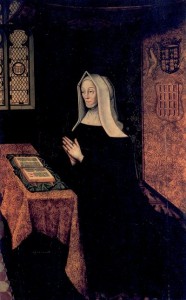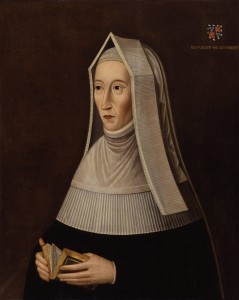- Lady Margaret Beaufort, c. 1500.
- Portrait of Lady Margaret Beaufort dressed as a widow, mother of Henry VII of England
Margaret Beaufort (1443[1]-1509) Born in Bedfordshire, England, Beaufort was the daughter of Margaret Beauchamp and John Beaufort, first Duke of Somerset. At her father’s death, possibly a suicide after being accused of treason, she became the heir to his fortune.[2] When Beaufort was six years old she was married to John de la Pole, the seven-year old son of William de la Pole , who was in political trouble and sought to link his son to the powerful Beaufort family for his protection.[3] This marriage, however, was annulled in 1453, and Beaufort was married again in 1455 to the twenty-four year old Edmund Tudor, as arranged by King Henry VI. Instead of waiting until she was fourteen to consummate the marriage, as was customary for child brides in the Middle Ages,[4] Beaufort became pregnant at the age of twelve. While she was pregnant, the War of the Roses broke out, her husband was taken captive during a military operation, and he died of the plague in 1456. In January of 1457, Beaufort gave birth to a son whom she named Henry, after the king. The birth was difficult and left her unable to bear any more children.[5]
In c.1457 Beaufort married her second cousin, Henry Stafford, a match she had a hand in arranging. As a powerful figure in the Beaufort family, she spent the next several years strategizing in an attempt to secure the safety of her family. At the age of twenty-two, Beaufort, who was deeply religious, and her mother chose to enter the confraternity of the Abbey of Croyland, a voluntary religious institution for lay people.[6] Fearing for her life in light of political vendettas against her family, Beaufort later retreated to another confraternity, the Order of the Holy Trinity, where she also obtained admission for her eight-year-old son.[7]
In 1466 King Edward IV granted Beaufort and her husband the Beaufort manor, which had previously been in royal hands, thus restoring them to political influence. But in 1471 Sir Henry Stafford died from a battle wound, leaving Beaufort a widow once more. Beaufort’s political and strategic brilliance was evident when, a few months later in 1472, she chose to marry again, this time to Thomas, Lord Stanley, the steward to the restored King Edward IV’s household.[8] The marriage enabled Beaufort to return to the court and serve Queen Elizabeth Woodville. Using her new connections, she sought to secure the return of her son, who had been exiled to Brittany. Edward IV granted Henry Tudor a royal pardon in 1476, and sent an English envoy to retrieve him from Brittany, but Henry escaped, fearing for his life and doubting Edward IV’s good faith. In 1483 Edward IV became ill and died, and his younger brother, Richard, Duke of Gloucester, seized the throne, claiming Edward IV’s sons, Edward V and Richard, were illegitimate. Richard III locked Edward IV’s young sons in the Tower of London and his queen and daughters were forced to withdraw to Westminster Abbey. The boys were never seen again and were presumed murdered.[9]
Beaufort served the new queen, Anne Neville, at court, and there were many who suspected she was involved in the murders. However, there is evidence that Beaufort was part of an unsuccessful plot to rescue the young princes from the Tower and overthrow Richard III.[10] After her involvement was discovered, Richard III spared her life only because of her husband’s loyalty throughout the uprising. In 1484 she was ordered to forfeit all rights to aristocratic titles and estates; she was stripped of her income and confined without servants. However, that year her son Henry returned to England with the backing of the French army, killed Richard III, and took the English throne as Henry VII.
Beaufort was a powerful figure in Henry VII’s court, and was given the title of Countess of Richmond and Derby. In 1488, both she and Henry’s wife, Elizabeth of York, received liveries of the Order of the Garter, a sign of special standing. She was one of her son’s most trusted counselors and contributed financially to his expeditions. Beaufort was a supporter of education and founded lectures at both Cambridge and Oxford.[11] Famous for her lifelong religiosity[12], in 1499 she took a vow of chastity in the presence of Richard FitzJames, Bishop of London, and moved out of her husband’s home with his blessing.[13] She died in 1509, two months after her son’s death of tuberculosis and six days after the marriage of her grandson, Henry VIII, to Catherine of Aragon.
[1] Philippa Gregory, “Beaufort, Margaret,” Mary Hays, Female Biography; or, Memoirs of Illustrious and Celebrated Women, of All Ages and Countries (1803). Chawton House Library Series: Women’s Memoirs, ed. Gina Luria Walker, Memoirs of Women Writers Part II (Pickering & Chatto: London, 2013), vol. 1, 260-72, editorial notes, 450-53, on 468.
[2] Philippa Gregory, The Women of the Cousins’ War: the Duchess, the Queen, and the King’s Mother (New York: Simon & Schuster, 2011), 243.
[3]Gregory, The Women of the Cousins’ War, 258-60.
[4] Gregory, The Women of the Cousins’ War, 265.
[5] Gregory, The Women of the Cousins’ War, 254-67.
[6] Gregory, The Women of the Cousins’ War, 276-77.
[7] Gregory, The Women of the Cousins’ War, 277.
[8] Sarah Gristwood, Blood Sisters: The Women Behind the War of the Roses (New York: Basic Books, 2013), 126-7.
[9] Alison Weir, The Princes in the Tower (New York: Ballantine Books, 1992), 163-78.
[10] Gregory, The Women of the Cousins’ War, 304-6.
[11] Mary Hays, “Margaret Beaufort,” Female Biography; or Memoirs of Illustrious and Celebrated Women of all Ages and Countries (6 volumes) (London: R. Phillips, 1803), vol. 1, 260-272, on 261-262; also Gristwood, Blood Sisters, 309-10.
[12] Hays, “Margaret Beaufort,” vol. 1, 260-72, on 265-67.
[13] Gristwood, Blood Sisters, 308-9.
Bibliography:
Ballard, George. Memoirs of Several Ladies of Great Britain Who Have Been Celebrated For Their Writings Or Skills In the Learned Languages Arts and Sciences. Oxford: W. Jackson, 1752.
Castor, Helen. She-wolves: the women who ruled England before Elizabeth New York: HarperCollins, 2011.
Fisher, John and Cecilia Hatt,. The English Works of John Fisher, Bishop of Rochester: Sermons and Other Writings, 1520-1535. Oxford Scholarship online. November 2003.
Fisher, Saint John. The funeral sermon of Margaret, Countess of Richmond and Derby, mother to King Henry VII. And foundress of Christ’s, and St John’s College in Cambridge. London: A. Bosvile, 1708.
Gregory, Philippa. “Beaufort, Margaret,” Mary Hays, Female Biography; or, Memoirs of Illustrious and Celebrated Women, of All Ages and Countries (1803). Chawton House Library Series: Women’s Memoirs, ed. Gina Luria Walker, Memoirs of Women Writers Part II (Pickering & Chatto: London, 2013), vol. 1, pp. 260-272, editorial notes 450-53.
Gregory, Philippa. The women of the Cousins’ War: the Duchess, the Queen, and the King’s Mother New York : Simon & Schuster, 2011.
Gristwood, Sarah. Blood Sisters: The Women Behind the War of the Roses. New York: Basic Books, 2013.
Halstead, Caroline Amelia. Life of Margaret Beaufort, Countess of Richmond and Derby. London: Smith, Elder and Co. Cornhill, 1839.
Hays, Mary. “Margaret Beaufort.” Female Biography; or, Memoirs of Illustrious and Celebrated Women of all Ages and Countries (6 volumes). London: R. Phillips, 1803, vol. 1, 260-72.
Jones, Michael. ‘Margaret Beaufort, 1443-1509’. In The Women of the Cousins’ War: The Duchess, the Queen, and the King’s Mother, 241–305. Simon and Schuster, 2011.
Jones, Michael J. and Malcolm G. Underwood. The King’s Mother: Lady Margaret Beaufort, Countess of Richmond and Derby. Cambridge University Press, 1992.
Jortin, John. The Life of Erasmus in Two Volumes, vol. one. London: J. Whiston and B. White, 1758.
“Margaret Beaufort,” In Biographia Britannica, vol. 1, 618-620. William Oldys, Ed. London, 1747.
Nichols, Francis M. The Epistles of Erasmus, 1st edition, 3 vols. London: Longmans, Green, and Co., 1901.
Norton, Elizabeth. Margaret Beaufort: Mother of the Tudor Dynasty. Gloucestershire: Amberley, 2010.
Walpole, Horace. A Catalogue of the royal and noble authors of England. Cambridge, W.H. Lunn, 1796.
“Wimborne Minster: A Brief History.” In Wimborne Minster Web Page. Accessed: August 20, 2012. http://wimborneminster.org.uk/history.html
Page Citation:
Lindsay Smith. “Margaret Beaufort.” Project Continua (March 15, 2015): Ver. 1, (date accessed), http://www.projectcontinua.org/margaret-beaufort/
Tags: End of Renaissance, Philanthropists, Reformation, Renaissance


